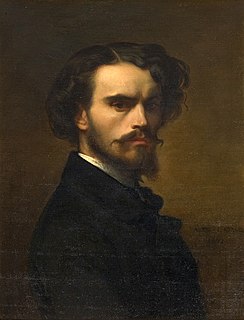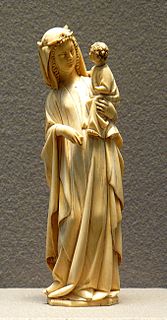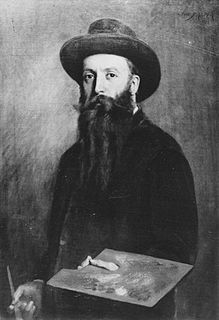

(sketch, 1875?)
Jean Seignemartin (16 April 1848, Lyon - 29 November 1875, Algiers) was a French painter of the Lyon School. [1] [2]


Jean Seignemartin (16 April 1848, Lyon - 29 November 1875, Algiers) was a French painter of the Lyon School. [1] [2]
His father was a weaver. Having shown artistic talent, in 1860 he was enrolled at the École nationale des beaux-arts de Lyon, [3] where he studied with Michel Philibert Genod and Joseph Guichard. He graduated in 1865 with the "Laurier d’or" [4] and shared a studio with his friend, François Vernay . [5]
In 1870, at the beginning of the Franco-Prussian War, [6] he was drafted and assigned to a unit of pontonniers from Paris. This involved being almost constantly in the water (even during winter), which resulted in infections that led to tuberculosis.
After his return, he helped decorate Frigolet Abbey under the direction of Antoine Sublet. Later, he settled into his own studio in Lyon, where he attracted notable patrons such as Dr. Raymond Tripier and the banker R. Stengelin, [1] father of the painter Alphonse Stengelin (1852-1938).
In 1874, he went to Algeria, accompanied by Doctor Tripier. There he met Albert Lebourg, [7] a professor at the École supérieure des beaux-arts d'Alger , who had a major influence on his style. In spring of the following year, he returned to Lyon, but went back to Algeria shortly thereafter on the advice of his doctors. [2] He died that winter. It took several weeks to arrange for the transport of his body, which was interred at the Cemetery of Loyasse. [8] A public subscription was taken up to adorn his tomb with a bronze bust by Étienne Pagny .
He painted portraits, genre scenes and still lifes of flowers, but his paintings from Algeria are his best-known works. A street in the 8th arrondissement of Lyon is named after him.

Alexandre Cabanel was a French painter. He painted historical, classical and religious subjects in the academic style. He was also well known as a portrait painter. According to Diccionario Enciclopedico Salvat, Cabanel is the best representative of the L'art pompier and Napoleon III's preferred painter.

Théodore Chassériau was a Dominican-born French Romantic painter noted for his portraits, historical and religious paintings, allegorical murals, and Orientalist images inspired by his travels to Algeria. Early in his career he painted in a Neoclassical style close to that of his teacher Jean-Auguste-Dominique Ingres, but in his later works he was strongly influenced by the Romantic style of Eugène Delacroix. He was a prolific draftsman, and made a suite of prints to illustrate Shakespeare's Othello. The portrait he painted at the age of 15 of Prosper Marilhat, makes Théodore Chassériau the youngest painter exhibited at the Louvre museum.

French art consists of the visual and plastic arts originating from the geographical area of France. Modern France was the main centre for the European art of the Upper Paleolithic, then left many megalithic monuments, and in the Iron Age many of the most impressive finds of early Celtic art. The Gallo-Roman period left a distinctive provincial style of sculpture, and the region around the modern Franco-German border led the empire in the mass production of finely decorated Ancient Roman pottery, which was exported to Italy and elsewhere on a large scale. With Merovingian art the story of French styles as a distinct and influential element in the wider development of the art of Christian Europe begins.

Anne-François-Louis Janmot was a French painter and poet.
Pierre Étienne Rémillieux (1811–1856) was a French painter.

The Lyon School is a term for a group of French artists which gathered around Paul Chenavard. It was founded by Pierre Revoil, one of the representatives of the Troubadour style. It included Victor Orsel, Louis Janmot and Hippolyte Flandrin, and was nicknamed "the prison of painting" by Charles Baudelaire. It was principally inspired by philosophical-moral and religious themes, and as a current was closely related to the British Pre-Raphaelite painters and poets.

François-Émile de Lansac was a French painter.

Jean Raymond Hippolyte Lazerges (1817–1887) was a French painter, and composer of mélodies and chansons.

Jean Messagier was a French painter, sculptor, printmaker and poet. Jean Messagier had his first solo exhibition in Paris at Galerie Arc-en-Ciel in 1947. From 1945 to 1949 the artist worked under the influence of Pablo Picasso, André Masson, Paul Klee and François Desnoyer, his professor at École nationale supérieure des arts décoratifs in Paris. Messagier again was revealed to the public at an exhibition organized by Charles Estienne at the Galerie de Babylone in 1952, entitled "La Nouvelle École de Paris". The following year, Messagier deliberately broke away from his expressionistic form of Post-Cubism; his inspirations now focused on Jean Fautrier and Pierre Tal-Coat to develop a personal vision in which he renders "light...approached abstractly." Jean Messagier is often associated with Lyrical abstraction, Tachisme, Nuagisme, Art informel and paysagisme abstrait, though the artist himself had never accepted any labels, and had always refused the distinction between abstraction and figuration. From 1962 until the year of his death Jean Messagier exhibited in France and abroad, taking part in some major international events as a representative of new trends in French painting.

Paul Alexandre Alfred Leroy was a French painter noted for Orientalist works. He was a founding member of the Société des Peintres Orientalistes Français and designed the Society's first logo.

Paul Biva was a French painter. His paintings, both Realist, Naturalist in effect, principally represented intricate landscape paintings or elaborate flower settings, much as the work of his older brother, the artist Henri Biva (1848–1929). Paul Biva was a distinguished member of National Horticultural Society of France from 1898 until his untimely death two years later.

Alphonse Stengelin (1852-1938) was a French painter, engraver, and lithographer who spent much of his life working outside France. He is remembered mostly for his landscapes.

Jean-Baptiste Olive was a French painter.

Zacharie Charles Landelle was a French painter who specialized in portraits. He is best known for his Orientalist works.

Simon Saint-Jean was a French painter who specialized in flowers.

Jean-Michel Grobon was a French painter and engraver; primarily of landscapes and genre scenes. He is considered to be a major representative of the Lyon School.

Georges Washington was a French Orientalist painter. Most of his works featured soldiers and horses.

Jean-Pierre Laurens was a French painter; primarily of figures and portraits.

Marie Joseph Jean Raymond Silbert, known as José Silbert was a French Orientalist painter.

Étienne Philippe Martin was a French painter, composer and writer.
![]() Media related to Jean Seignemartin at Wikimedia Commons
Media related to Jean Seignemartin at Wikimedia Commons